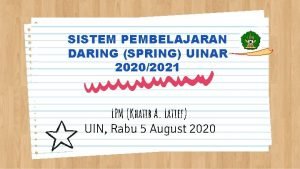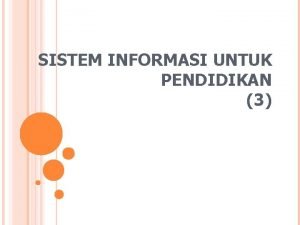Presence within synchronous versus asynchronous online nursing education

- Slides: 1

Presence within synchronous versus asynchronous online nursing education. Karen Hocking, RN State University of New York Polytechnic Institute Department of Nursing Abstract PICO STATEMENT – In online nursing education, how does learning with synchronous collaborate sessions as compared to traditional online learning with asynchronous course discussions influence the sense of community (presence) in regard to both student and faculty perspectives? Synchronous collaborate sessions versus asynchronous course discussions, in online Nursing education, can be used more interactively to facilitate Nursing presence by: • • Actively engaging the student in the learning process via immediate discussions Employing cooperative learning via synchronous group activities, case studies, and games Employing creativity by teaming students up to work privately in live groups Utilizing live question and answer sessions Introduction Asynchronous course discussions in online Nursing education have been the online educational mainstay for a number of years. With the advent of synchronous collaborate sessions, Nursing education is becoming more real-time; thus creating a need for a sense of learner and instructor presence in the online environment. Olson and Benham-Hutchins (2014) discuss the many definitions of the word “presence, ” stating that the “modern day definitions include: being present or in proximity with” (as cited in Dictionary. com Unabridged Website, n. d. ). Also noted by Olson and Benham-Hutchins (2014) is that “nurses who portray presence have been described as possessing both personal and professional maturity (as cited in Easter 2000) and have an ability to base their practice on the moral and ethical principles of commitment and respect for individual differences” (as cited in Hines 1992; Cavendish et al. 2003). Thirdly, also noted by Olson and Benham-Hutchins (2014) is that “presence in online nursing education has been described as a convergence of nursing, education, and technology, characterized by connection with others in a virtual world” (as cited in Kaiser 2004). According to Claman (2015) “the lack of human interaction may be an obstacle to online learning. The perception of ‘presence’ has been shown to be lower for students using a primarily asynchronous internet-based learning platform compared to live classroom instruction, thereby reducing student engagement” (as cited in Sit et al. , 2005). Vigil (2015) states that “another aspect of teacher presence is tied to creating a community of inquiry where interaction and reflection are sustained; where ideas can be explored and critiqued; and where the process of inquiry can be scaffolded and modeled” (as cited in Garrison & Cleveland-Innes, 2005). Vigil (2015) goes on to say that “this transcends social interaction and basic sharing of information. The goal of establishing an interactive community of inquiry is to engage students in meaningful ways that stimulate their cognitive growth and development. ” Article Search • • • CINAHL Plus with full text MEDLINE GOOGLE Scholar Peer reviewed journals Research conducted in the U. S. between 2002 and 2015 Fourth year undergrad and grad Nursing students Methodology An integrative review was done on the literature comparing synchronous online learning versus asynchronous online learning with regard to perceived learner and instructor presence. The articles summarized for the review went back to 2002, due to the fact of the limited number of articles since that time on the topic. The integrative literature review was done in order to formulate conclusions regarding the topic. Search terms included “learner presence in online education, ” “teacher presence in online education, ” “learner presence in synchronous versus asynchronous online nursing education, ” and “teacher presence in synchronous versus asynchronous online nursing education. ” The results of the review will be presented at the April 2015 Curriculum Committee at SUNY Polytechnic Institute. Literature Review Claman (2015) states that “asynchronous methods offer the learner static instructional content and provide tools for critical thinking by giving students the opportunity for reflective inquiry through posts and blogs. Using synchronous platforms has been demonstrated to increase student satisfaction and improve communication. ” Claman (2015) also mentions that “synchronous learning methods increase student achievement and satisfaction. Students report that synchronous activities facilitate their understanding of course content and describe them as challenging, engaging, and providing a high degree of perceived learning. ” Gunderson (2014) states that “the online instructor has the responsibility to develop a sense of community from day one and to attempt to foster engagement in students. Teacher immediacy and methods for reducing interpersonal distance require timely, constructive feedback, a means of reinforcing the instructor’s social presence. ” Morrison (2014) states that “more than one study suggests that synchronous communication activities support the social needs of online students not typically met in the asynchronous format, ‘Social support is desirable as a way to foster knowledge work and collaborative learning; it provides an environment where communication is encouraged; e. g. , anecdotes and personal experiences encourage trust, which foster receptive and creative learning environment’” (as cited in Hranstinski, 2008). Conclusion Project Implementation Nursing education has experienced a rapid expansion of online courses and programs offered within the last few years. The studies reviewed showed various factors with regard to both student and teacher presence in the online classroom situation. More studies need to be done on this topic which will enable institutions of higher learning to make choices which benefit both instructor and student with regard to their online platforms. Within many institutes of higher learning there has been a sharp growth of online classes and curricula being offered for nurses. Faculty educators would benefit greatly from a better understanding of what is behind instructor and learner presence in online nursing education. According to Lowenthal and Parscal (2008) “there are many strategies for creating teaching presence within an online course. The following table highlights strategies related to instructional design, teaching, and student learning for creating teaching and social presence. ” Questions for further research INSTRUCTIONAL DESIGN TEACHING STUDENT LEARNING Develop overviews. Post introduction and expectation documents before the students are given access to the course. Contribute to discussion forum throughout the week as opposed to waiting for the weekend. 1. Provide opportunities for student and profiles within the learning/teacher management system. Contribute to discussion forum throughout the week. Promptly answer emails. 3. Incorporate audio and video within the course content following best practices for teaching and learning and ADA compliance standards. Provide suggested due dates for initial postings that promote mid-week engagement as opposed to weekend only postings. Share personal stories and experiences. Limit class size. Launch discussion threads and summarize each thread at the end of the week. Use expressions of emotions, e. g. (smile) or (grin). Structure collaborative learning activities. Strike up a conversation. Promptly answer e-mail. Utilize group work strategies. Develop open-ended, critical thinking discussion questions. Promptly answer e-mail. Provide frequent feedback. Send progress reports on participation and quality of postings. Incorporate reflective activities. Utilize continuous and authentic assessment strategies 2. What are the advantages and disadvantages for students and faculty of increasing technology-based learning presence? How do instructors create/build presence in themselves in their online classrooms? How can instructors more effectively create/build presence in their students online? Ask open-ended questions that promote discussion and require critical thinking. References Claman, F. L. (2015). The impact of multiuser virtual environments on student engagement. Nurse Education In Practice, 15(1), 13 -16. doi: 10. 1016/j. nepr. 2014. 11. 006 Gunderson, B. J. , Theiss, M. A. , Wood, L. K. , & Conti-O'Hare, M. (2014). Using a telephone call to increase social presence in online classes. Nursing Education Perspectives, 35(5), 338 -339. Lowenthal, P. and Parscal, T. (2008). Teaching Presence Online Facilitates Meaningful Learning. The Learning Curve, 1(2), 1 -2 & 4. Morrison, D. (2014, March 9). The Next-Big-Thing In Online Education: Learning in Real Time. Retrieved from https: //onlinelearninginsights. wordpress. com/tag/synchronoustools-for-online-learning/ Olson, C. C. and Benham-Hutchins, M. (2014). Learner Presence in Online Nursing Education. Online Journal of Nursing Informatics, 18(3), 1. Vigil, V. (2014). Meaningful Learner: Teacher Presence and Learner Engagement in the Online Classroom. Edutopia. http: //www. edutopia. org/discussion/meaningful-learning-teacher-presencelearner-engagement-online-classroom Acknowledgements I would like to acknowledge Professor Francia Reed for help in making this poster presentation possible.

